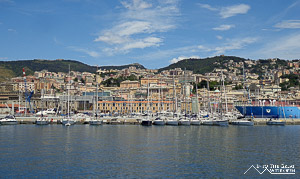Genoa, Italy
An Old Mediterranean Port
July 24, 2012
Some had scars and some had scratches
It made me wonder about their past
And as I looked around I began to notice
That we were nothing like the rest
- Of Monsters and Men

It’s not exactly easy turning up in a city with no guide book or information of any sort, especially if it is early on a Sunday evening in Italy. A free map from the information desk was useful and allowed me to find the bus station, except that there really is no bus station. The bus station is a street along a big plaza where buses stop as they pass through town. I have seen similar bus “stations” in small towns but this seemed absurd considering Genoa is Italy’s sixth largest city. Being Sunday evening every office was closed and there were no sources of information, let alone any place resembling a ticket office or something with a bus schedule. At least I had 24 hours, in theory, until the next bus to Barcelona, hopefully plenty of time to figure everything out.

Figuring out Genoa was equally complex. It is a city with an extensive history as an important Italian port and to this day is still a critical industrial hub. With the importance of seafaring in the economies and daily life during the Renaissance the commercial successes of the city created a wealthy class of merchants and tradesman. These aristocrats commissioned numerous palaces and a large section of the old city has been listed as a UNESCO World Heritage Site. The palaces are supposedly richly furnished and contain artworks from some of top artists in Europe during this era. Of course I wouldn’t know about that because every single museum and historical building is closed on Mondays, my only day in the city.
It is probably because of this that the city was surprisingly empty. I have a suspicion that cruise ships don’t dock here on Mondays when everything is closed and for me that is a fair trade-off. Wandering through the empty maze of narrow streets in the old city you get a good impression of the sense of history and probably how unsavory it was to live in such a densely populated area without any of the conveniences of modern society. Some things, I think are still the same as they were several hundred years ago. Rounding the corner from an old church and a school I stumbled onto a side street and saw rows of women sitting on stools or standing up by doorways. At first I thought it was rather strange on an otherwise deserted street until I noticed how they were dressed and realized they were all prostitutes. It was an interesting walk between them but despite the looks that spoke volumes they were almost silent.

In contrast, the area by the old port has been completely cleaned up and renovated. There is a new aquarium, one of the largest in Europe, a swimming pool with water aerobics classes, and lines of boats, big and small, filling the harbor docks. From the harbor the hills rise sharply upwards and are covered in a mixture of trees and houses. On the hilltops, in strategic positions there are ruins of castle walls and forested parks serving as a nice escape from the congested city below. In recent years Genoa has been the subject of extensive efforts at urban redesign, something of a makeover for such an aging yet still prominent city. So far this seems to be a big success and the city functions well at many levels.

One of the more interesting aspects of the city that the urban planning seems unlikely to address is the vast immigrant population. If you walk through the back streets of the old city there is a sizeable population from North and sub-Saharan Africa as well a large amount of people from the Middle East, something I would not have expected here. In a way it seems fitting that here in Italy, nearly at the end of my trip across Asia to Europe that I come into contact with people from Africa.
Speaking of the end of my trip, I have only one more leg of the journey to make. With no bus station here in Genoa I was able to find a ticket office at a travel agency to buy my last bus ticket. Like so many other days of this trip, whether it was in Tajikistan or Turkey, I find myself once again standing on the side of a road in the depths of the night at some random location waiting for a bus. Even in Italy.






























































